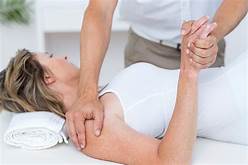The aim of this evaluator-blinded randomized clinical trial was to determine if manual therapy added to a therapeutic exercise program produced greater improvements than a sham manual therapy added to the same exercise program in patients with non-specific shoulder pain. 
Forty-five subjects were randomly allocated into one of three groups:
- manual therapy (glenohumeral mobilization technique and rib-cage technique);
- thoracic sham manual therapy (glenohumeral mobilization technique and rib-cage sham technique);
- sham manual therapy (sham glenohumeral mobilization technique and rib-cage sham technique).
All groups also received a therapeutic exercise program. Pain intensity, disability, and pain-free active shoulder range of motion were measured post-treatment and at 4-week and 12-week follow-ups. Mixed-model analyses of variance and post hoc pairwise comparisons with Bonferroni corrections were constructed for the analysis of the outcome measures.
All groups reported improved pain intensity, disability, and pain-free active shoulder range of motion. However, there were no between-group differences in these outcome measures.
The authors concluded that the addition of the manual therapy techniques applied in the present study to a therapeutic exercise protocol did not seem to add benefits to the management of subjects with non-specific shoulder pain.
What does that mean?
I think it means that the improvements observed in this study were due to 1) exercise and 2) a range of non-specific effects, and that they were not due to the manual techniques tested.
I cannot say that I find this enormously surprising. But I would also find it unsurprising if fans of these methods would claim that the results show that the physios applied the techniques not correctly.
In any case, I feel this is an interesting study, not least because of its use of sham therapy. But I somehow doubt that the patients were unable to distinguish sham from verum. If so, the study was not patient-blind which obviously is difficult to achieve with manual treatments.

Another silly study of taking a nonspecific condition and applying generic treatments revealing they don’t have long term benefits either alone or in combination. Yes, the results aren’t surprising.
And this reference doesn’t even back up their statement:
“The first choice of treatment for NSSP is physiotherapy [2].”
(2) Arthroscopic subacromial decompression for subacromial shoulder pain (CSAW): a multicentre, pragmatic, parallel group, placebo-controlled, three-group, randomised surgical trial
For chronic pain, we don’t yet have a study that shows that any type of physiotherapy is superior to merely remaining active. Yet instead of supporting people to remain active, many physiotherapists vehemently claim that specific exercises are helpful and even essential, to the extent that they will attack anyone who suggests otherwise.
True. One the barriers to get patients with chronic pain to be more active is fear of movement…kinesiophobia.
One thought is that when a therapist does active and passive exercise/movement or therapies with a patient is that it helps to reduce that fear and thus they are more likely to be active outside the clinic.
Edzard I’d like to see physios guiding and supporting active recreational choices that the client is more likely to continue over the lifetime. The emphasis on specific exercises leads to a misunderstanding that it’s the specificity that’s causing any improvement.